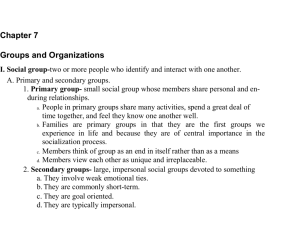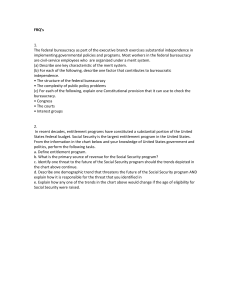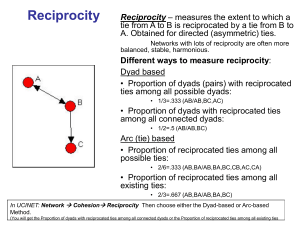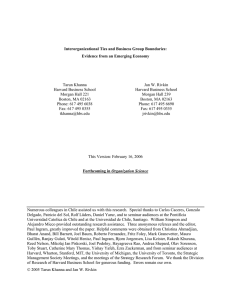Chapter 6 - WW Norton & Company
advertisement
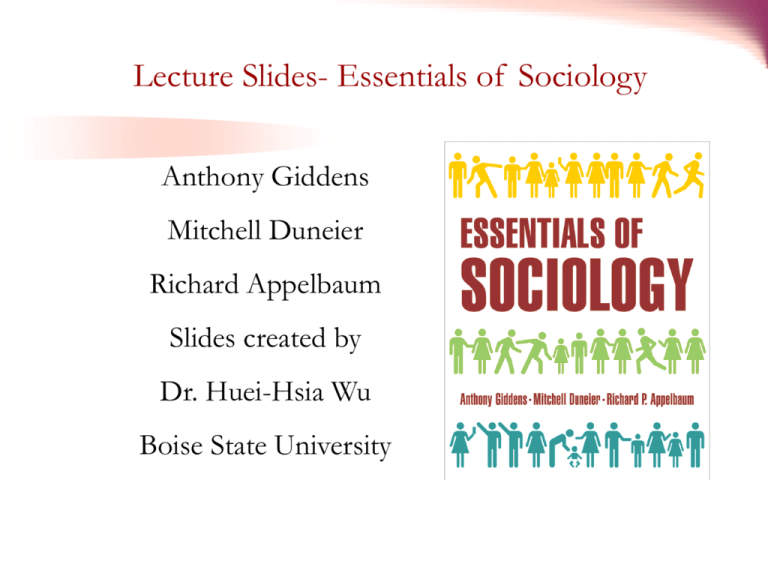
Lecture Slides- Essentials of Sociology Anthony Giddens Mitchell Duneier Richard Appelbaum Slides created by Dr. Huei-Hsia Wu Boise State University Chapter 5 Groups, Networks, and Organizations SOCIAL GROUPS (pp. 120-122) Types of social groups: In-groups Out-groups Primary groups Secondary groups Reference groups SOCIAL GROUPS Group size is an important factor in group dynamics. Although their intensity may diminish, larger groups tend to be more stable than smaller groups of two (dyads) or three (triads). Groups of more than a dozen or so people usually develop a formal structure. Group Size (p. 122) Dyads: a group with two members Triads: a group with three members Leaders (p. 124) Transactional leaders are concerned with accomplishing the group’s tasks. Transformational leaders change the nature of the group itself. Conformity Research indicates that people are highly conformist to group pressure. Many people will do what others tell them to do, even when the consequences involve injury to others, as demonstrated by Stanley Milgram. Conformity Research Solomon Asch (1952) In the Asch task (see next slide), participants were shown a standard line (left) and then three comparison lines. Their task was simply to say which of the three lines matched the standard. When confederates gave false answers first, three-quarters of participants conformed by giving the wrong answer. (pp. 124-125) Stanley Milgram (1963) Milgram’s research showed that ordinary people will conform to orders given by someone in a position of power or authority, even if those orders have horrible consequences. (p. 125) NETWORKS Networks constitute a broad source of relationships, direct and indirect, including connections that may be extremely important in business and politics. (p. 126) Women, people of color, and lower-income people typically have less access to the most influential economic and political networks than do white males in American society. ORGANIZATIONS An organization is a group with an identifiable membership that engages in concerted collective actions to achieve a common purpose. (pp. 128-129) A formal organization is rationally designed to achieve its objectives, often by means of explicit rules, regulations, and procedures. (p. 129) ORGANIZATIONS Organizations provide coordination of activities and resources needed to sustain our lives. Organizations also have the effect of taking things out of our own hands and putting them under the control of officials or experts over whom we have little influence. THEORIES OF ORGANIZATIONS Bureaucracy (p. 130) Rule of officials The term first applied only to government officials, but it gradually was extended to refer to large organizations in general. Max Weber developed the first systematic interpretation of the ruse of modern organizations, and argued that the expansion of bureaucracy is inevitable in modern societies. THEORIES OF ORGANIZATIONS The work of Weber and Michels identifies a tension between bureaucracy and democracy. On the one hand, long-term processes of the centralization of decision making are associated with the development of modern societies. On the other hand, one of the main features of the past two centuries has been expanding pressures toward democracy. The trends conflict, with neither one in a position of dominance. Gender and Organizations Modern organizations have evolved as gendered institutions. Women have traditionally been segregated into certain occupational categories that support the ability of men to advance their careers. In recent years, women have been entering professional and managerial positions in greater numbers, but some believe that women have to adopt a traditionally male management style in order to succeed at top levels. BEYOND BUREAUCRACY? Some large organizations have restructured themselves over recent years to become less bureaucratic and more flexible. Many Western firms have adopted aspects of Japanese management systems: more consultation of lower-level workers by managerial executives; pay and responsibility linked to seniority; and groups, rather than individuals, evaluated for their performance. Alternatives to Bureaucracy New information technology is changing the way in which organizations work. Many tasks can now be completed electronically, which can allow organizations to transcend time and space. The physical boundaries of organizations are being eroded by the capabilities of new technology. Many organizations now work as loose networks, rather than as self-contained independent units. Social Capital Social capital refers to the knowledge and connections that enable people to cooperate with one another for mutual benefit and extend their influence. Some social scientists have argued that social capital has declined in the United States during the last quarter century, a process they worry indicates a decline in Americans’ commitment to civic engagement. Concept Quiz 1. According to Foucault, what is the significance of the architecture of the building in which an organization is housed? a. It often shows who built the building and who owns the company it houses. b. It expresses the patterns of authority in an organization that enable supervisors to monitor the work of. c. The size of a building and the complexity of its layout are indicative of the size of the company. d. It expresses the patterns of equality in an organization. Concept Quiz 2. The term for the social knowledge and connections that enable people to accomplish their goals and extend their influence is a. cultural capital. b. political capital. c. social capital. d. economic capital. Concept Quiz 3. Which of the following best characterizes how human history has unfolded with regard to primary and secondary groups? a. For most of human history, nearly all interactions took place within primary groups, whereas today most of our waking hours are spent within secondary groups. b. Throughout history, the predominance of primary versus secondary groups has shifted cyclically with economic boom and bust. c. Over time, primary groups have gained more power vis a vis secondary groups, leaving secondary groups struggling for the remainder of the scarce resources. d. The initial mutual suspicion between primary and secondary groups has given way, in the last two decades, to a tentative cooperation in the political arena. Concept Quiz 4. Which of the following did sociologist Mark Granovetter demonstrate about the importance of weak ties? a. that if weak ties are not eventually strengthened the relationship atrophies and the bond can be lost forever b. that weak ties are central to explaining how children from single-parent households more easily fall prey to criminal lifestyles than do other children c. that weak ties can remain weak indefinitely without harm and will always respond to strengthening efforts if a bonding attempt is made d. that weak ties are particularly key in helping people with higher socioeconomic status gain a new job This concludes the Norton Media Library Slide Set for Chapter 5 Essentials of SOCIOLOGY by Anthony Giddens Mitchell Duneier Richard Appelbaum W. W. Norton & Company Independent and Employee-Owned

